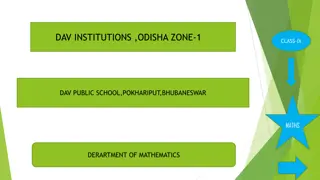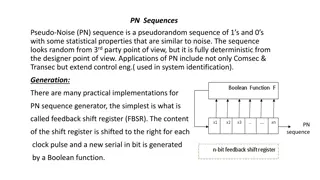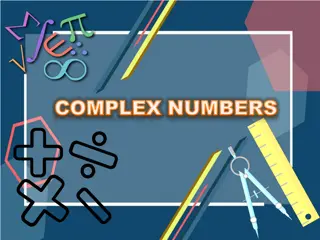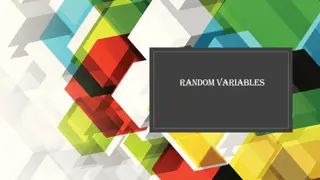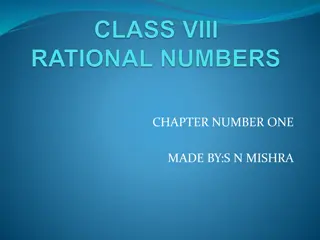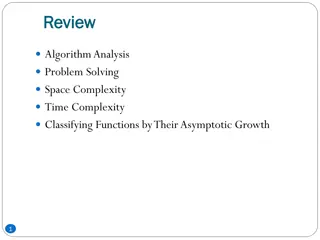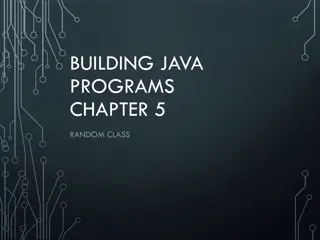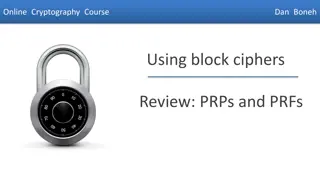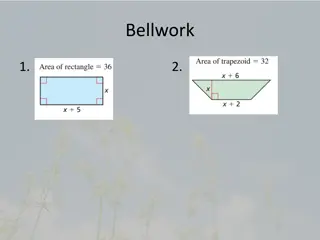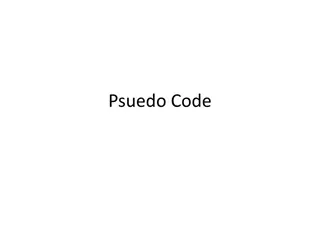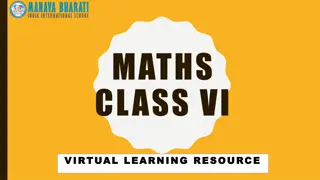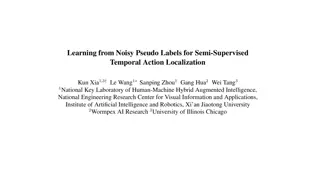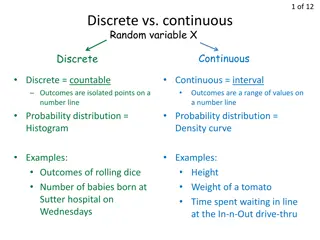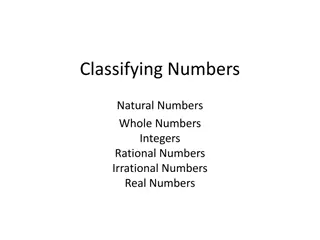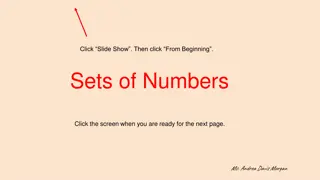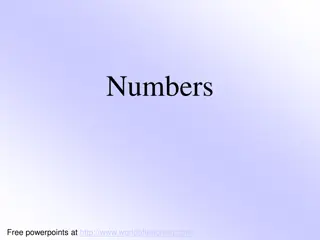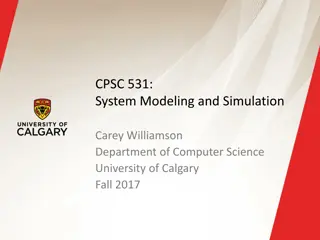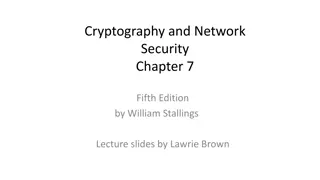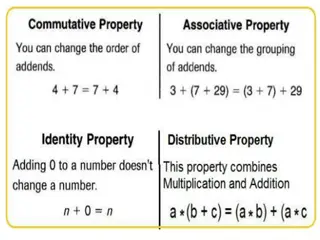Rational and Irrational Numbers in Mathematics
Explore the concept of rational and irrational numbers in mathematics through defining, distinguishing, computing, representing, and rationalizing these types of numbers. Learn about natural numbers, whole numbers, integers, rational numbers, and irrational numbers with clear examples. Answer common
1 views • 48 slides
Pseudo-Noise Sequences and Applications
Pseudo-Noise (PN) sequences are deterministic yet appear random, with applications in various fields such as communication security, control engineering, and system identification. Generated using shift registers, they exhibit statistical properties akin to noise. Linear and nonlinear feedback shift
2 views • 19 slides
High-Throughput True Random Number Generation Using QUAC-TRNG
DRAM-based QUAC-TRNG provides high-throughput and low-latency true random number generation by utilizing commodity DRAM devices. By employing Quadruple Row Activation (QUAC), this method outperforms existing TRNGs, achieving a 15.08x improvement in throughput and passing all 15 NIST randomness tests
1 views • 10 slides
Comprehensive Guide to Complex Numbers - Learning Objectives, Key Concepts, and Previous Knowledge Testing
This comprehensive guide provides detailed information on complex numbers, including learning objectives such as identifying complex numbers, applying algebra, understanding properties like conjugates and moduli, finding square roots, and representing in polar form. Key concepts covered include inte
3 views • 27 slides
Random Variables and Their Applications in Various Fields
Random variables play a crucial role in statistics, engineering, and business applications. They can be discrete or continuous, depending on the nature of the outcomes. Discrete random variables have countable values, while continuous random variables can take on any real number. This article explor
1 views • 6 slides
Real Numbers: Classification, Operations, and Examples
Real numbers encompass a wide range of mathematical entities, including natural numbers, whole numbers, integers, fractions, rational numbers, and irrational numbers. This chapter delves into the classification of real numbers, Euclid's Division Lemma and Algorithm, finding HCF and LCM using these m
4 views • 15 slides
Random Variables and Probability Distributions
Random variables are variables whose values are unknown and can be discrete or continuous. Probability distributions provide the likelihood of outcomes in a random experiment. Learn how random variables are used in quantifying outcomes and differentiating from algebraic variables. Explore types of r
2 views • 13 slides
Rational Numbers: A Comprehensive Overview
Discover the world of numbers with this comprehensive guide on different types of numbers, focusing on rational numbers. Learn about natural numbers, whole numbers, integers, and how rational numbers are represented on a number line. Dive into the properties of rational numbers and explore the conce
2 views • 19 slides
Pseudo Code and Flow Charts for Algorithm Analysis
Explore the concepts of pseudo code and flow charts for analyzing algorithms, problem-solving, and understanding space and time complexity. Learn about basic elements of pseudo code, assigning operations, and writing effective pseudo code statements in a clear and structured manner. Discover the imp
0 views • 26 slides
Prime Numbers and Greatest Common Divisors in Discrete Structures
Cryptography relies on prime numbers and the fundamental theorem of arithmetic to ensure security. We explore the concept of prime numbers, composite numbers, and how to test for primality using trial division. The Fundamental Theorem of Arithmetic establishes that every integer can be uniquely fact
1 views • 44 slides
Pseudo-Goodwin Cycles in a Minsky Model
This paper delves into the dynamics of Pseudo-Goodwin cycles within a Minsky model, examining the counter-clockwise movement of output and wage share. It distinguishes between true Goodwin cycles and pseudo variants, highlighting the role of income distribution, debt, and demand in shaping economic
1 views • 27 slides
Random Class in Java Programming
The Random class in Java is used to generate pseudo-random numbers. By utilizing methods such as nextInt and nextDouble, you can generate random integers and real numbers within specified ranges. This chapter explores common usage scenarios, such as generating random numbers between specific ranges
2 views • 10 slides
Secure PRFs and PRPs in Cryptography
Dive into the world of secure Pseudo-Random Functions (PRFs) and Pseudo-Random Permutations (PRPs) in cryptography. Learn about the definitions, security criteria, and examples of secure PRFs and PRPs such as 3DES and AES. Explore the concepts of secure block ciphers and key principles behind these
0 views • 54 slides
Random Numbers in Computers
Explore the concept of true random numbers versus pseudorandom numbers in computers. Learn how pseudorandom numbers are generated algorithmically but predictable, while true random numbers are derived from physical phenomena like radioactive decay. Discover the relevance of high-entropy pseudorandom
0 views • 57 slides
Complex Numbers in Mathematics
Learn about complex numbers, including real and imaginary parts, operations with complex numbers, the imaginary unit, equality of complex numbers, and finding square roots of negative numbers. Explore how to define and use the imaginary unit, add, subtract, and multiply complex numbers, find complex
0 views • 17 slides
Natural Numbers, Whole Numbers, and Roman Numerals
This chapter delves into the concepts of natural numbers, whole numbers, and Roman numerals. It covers the basics of numeral systems, properties of whole numbers, and rules for Roman numerals. Learn about counting numbers, place value, successors, predecessors, and more to build a strong mathematica
2 views • 11 slides
Place Value and Number Magnitudes
Explore the concept of place value in numbers up to seven digits, learn how to write numbers in figures, identify digit values, find the largest and smallest numbers, order numbers, and work on rounding and comparisons. Engage in exercises like recognizing digits, writing numbers in figures, circlin
0 views • 61 slides
Pseudo-Tie Business Procedure Tariff Administration, August 2017
Pseudo-tie business procedure tariff administration from August 2017 outlines the purpose, implementation, and types of pseudo-ties in the energy industry. It covers dynamic transfers, pseudo-tie procedures, and various stakeholder involvements. The document details the process of implementing pseud
0 views • 11 slides
Pseudo Code: A Beginner's Guide to Organizing Programs
Pseudo code is a helpful way to organize your program logic before actual coding. It provides a structured outline from inputs to outputs, focusing on step-by-step guidelines that are not language-specific. This guide covers the basics of pseudo code, including general guidelines, steps to pseudo co
2 views • 29 slides
A Zoo of Discrete Random Variables
Discrete random variables play a crucial role in probability theory and statistics. This content explores three key types: Bernoulli random variable, binomial random variable, and error-correcting codes. From understanding the basics of Bernoulli trials to exploring the application of error correcti
0 views • 27 slides
Mathematics: Class VI Syllabus Overview & Number Concepts
Delve into the Class VI mathematics syllabus, covering topics such as Knowing our Numbers, Basic Geometrical Ideas, Natural Numbers, and more. Explore the Hindu-Arabic system of numeration, ordering numbers, counting large numbers, and the significance of natural numbers in counting and ordering. En
1 views • 15 slides
Handling Label Noise in Semi-Supervised Temporal Action Localization
The Abstract Semi-Supervised Temporal Action Localization (SS-TAL) framework aims to enhance the generalization capability of action detectors using large-scale unlabeled videos. Despite recent progress, a significant challenge persists due to noisy pseudo-labels hindering efficient learning from ab
0 views • 30 slides
Random Variables and Mean in Statistics
Random variables can be discrete or continuous, with outcomes represented as isolated points or intervals. The Law of Large Numbers shows how the mean of observed values approaches the population mean as the number of trials increases. Calculating the mean of a random variable involves finding the e
0 views • 13 slides
Prime Numbers
Exploring the concept of prime numbers and how to identify them between 1 and 100. The process involves recognizing that prime numbers have only two factors - 1 and themselves. The visual representations help in shading non-prime numbers and multiples of 2, 3, and 5. By following the rules outlined,
1 views • 31 slides
Prime and Composite Numbers with GCF
Explore the concepts of prime and composite numbers, the difference between them, and how to find the Greatest Common Factor (GCF). Prime numbers have only two factors, 1 and the number itself, like 2, 3, 5. Composite numbers have more than two factors, such as 4, 6, 8. Learn to identify prime and c
3 views • 12 slides
Randomized Algorithms and Independence Concepts
Types of independence in randomized algorithms are explored alongside the concept of random bit complexity and generation. The idea of mutually independent random variables versus pairwise independent random variables is discussed, illustrating how to generate uniformly random and pairwise independe
1 views • 18 slides
Random Number and Variate Generation Overview
Random numbers play a crucial role in modern computing, aiding in cryptography, simulation, and system testing. This overview delves into the properties of random numbers, the generation of pseudo-random numbers, techniques for generating them, and tests for their validity. It explores the significa
0 views • 59 slides
Embedded Randomness in Operating Systems
Embedded systems require good random numbers for various tasks such as network packet collision avoidance, recovery from power outages, gaming, and cryptography. Learn about true random number generators, pseudo-random number generators, and efficient random number generation algorithms to ensure se
0 views • 23 slides
Randomness in Cryptography and Network Security: Unpredictability and Pseudorandom Numbers
The importance of random numbers in cryptography is emphasized, delving into the concepts of unpredictability, randomness, and pseudorandom number generation. The generation and validation of random sequences, along with the use of algorithmic techniques in cryptographic applications, are explored.
0 views • 43 slides
Different Types of Numbers
Natural numbers are positive whole numbers excluding zero, whole numbers include zero along with positive integers, integers encompass positive and negative whole numbers, rational numbers cover integers, fractions, and decimals, while rational numbers include all types of numbers mentioned. Classif
0 views • 26 slides
Types of Numbers: Natural, Whole, Integers, Fractions
In this presentation, you'll learn about different sets of numbers including natural numbers, whole numbers, integers, and fractions. Natural numbers are the counting numbers, whole numbers include positive numbers and zero, integers consist of whole numbers and their opposites, and fractions can be
0 views • 26 slides
Numbers and Number Systems
Delve into the world of numbers with a comprehensive overview covering topics such as perfect squares, square roots, irrational numbers, real numbers, natural numbers, whole numbers, integers, and rational numbers. Embrace the beauty and complexity of mathematics through detailed explanations and ca
0 views • 11 slides
Advanced Data Analysis Techniques for Statistical Inference
Explore the importance of computers in generating random numbers for statistical inference methods, testing new statistical approaches, and simulating complex models in data analysis. Understand the significance of pseudo-random number generation and linear congruential generators in producing appar
0 views • 42 slides
Discrete Random Variables and Associated Probability Functions
Explore the concept of discrete random variables, their associated probability mass functions, and examples of typical discrete random variables like the Binomial and Poisson random variables. Understand the difference between discrete and continuous random variables with practical examples.
0 views • 19 slides
System Modeling and Simulation in CPSC 531: Important Concepts and Algorithms
Explore essential topics in CPSC 531, including random number generation, properties of random numbers, linear congruential generator, and desirable properties of random number generators. Understand the significance of uniformity, independence, and sequence reproducibility in computer simulation. G
0 views • 18 slides
Understanding Complex Numbers in College Algebra
Explore the world of imaginary and complex numbers in college algebra, including the concept of imaginary numbers, complex numbers, plotting complex numbers, adding, subtracting, multiplying complex numbers, and dividing complex numbers. Discover how to represent and operate with complex numbers eff
0 views • 17 slides
Stream Ciphers, Random Numbers, and RNG in Cryptography
Explore the importance of random numbers in cryptography, the use of stream ciphers, and the generation of true random and pseudorandom numbers. Learn about natural random noise sources, published sources, and the challenges of creating secure pseudorandom number generators.
0 views • 20 slides
Random Number and Variate Generation Overview
Discover the importance of random number generation, including pseudo-random numbers and their applications in computing, cryptography, and simulation. Explore historical methods and properties of random numbers for effective simulation and system testing. Learn about the uniformity and independence
0 views • 59 slides
System Modeling and Simulation Recap: Random Number Generation and Variate Techniques
Explore the fundamental concepts of random number generation and variate techniques in system modeling and simulation. Topics include pseudo-random number generation, Bernoulli variates, and the inverse transformation method for discrete distributions.
0 views • 24 slides
Understanding Whole Numbers, Natural Numbers, and Integers
Explore the concepts of whole numbers, natural numbers, and integers in mathematics. Learn about multiplicatives inverses, counting numbers, and the different types of numbers that make up the number system. Dive into the world of integers, including negative numbers, positive numbers, and zero. Gai
0 views • 8 slides
